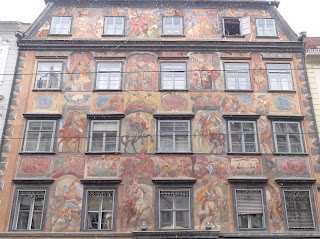Graz lies 210km south of Vienna and it is the second largest Austrian city. Like Salzburg, the city is divided by the River Mur with the old town and its narrow cobblestone streets to the south and the new town to the north.
We obtained a guide to exploring the sights of Graz which was divided into three separate walks, being:
1. Through the old town
2. Through the old town, across the river and back
3. From the rooftops
These spectacular walks completed in 2 days are best illustrated through the lens as a photo-journal.
Walk 1 - Through the old town
Landhaus Courtyard
An arcaded inner courtyard of Italian Renaissance, the Landhaus is currently used for state parliamentary meetings.
Herzoghof
Known as the "Painted House", the facade of this building was painted with frescoes in 1742 by Baroque artist Johann Mayer. The frescoes show the gods of Greco-Roman mythology.
Town Hall
Considered to be the heart of the city, the Town Hall with its dome, clock and corner towers has dominated Graz since the late 19th century.
Luegghaus
The Luegghaus is a striking building with an elaborate stucco facade. It is well complimented by its surrounding buildings and vibrant colours.
Double Spiral Staircase
This double spiral staircase built in 1499 is renown as a stone masonry masterpiece from the Gothic era.
Edegger-Tax Bakery
Crowned with a gilded double-headed eagle, this splendid wooden shop-facade is a bakery. Confectionery from the Imperial era such as the Sissibuserl or Kaiserzwieback biscuits are a specialty and may be sampled.
Stiegenkirche
The oldest parish church, it is now known as a church for students which is evident in its simplicity and the modern paintings.
Cathedral
This enormous and imposing cathedral was commissioned by Emperor Frederick III and built as a court church over 26 years starting in 1438.
Mausoleum
The final resting place for Emperor Ferdinand II, who commissioned this tomb for himself and his family, is today considered highly important in terms of art history.
Walk 2 - Across the Mur and Back Again
Kunsthaus Graz
It is a fantastic and somewhat awkward modern building in the midst of historical and traditional structures. Along with the Clock Tower on the opposite side of the river, the Kunsthaus is Graz’s trademark. The building is used to house temporary and photographic exhibitions.
Mariahilfer Square
A square dominated by the Mariahilfer church, the monastery and the cultural centre of the Minorites. The church was built early 17th century and double towers were added in 1742.
Murinsel
The Murinsel takes the form of a floating shell linking the two sides of the river by footbridges. It houses a café and amphitheatre.
Schlossberg Square
The 13th century Reinerhof situated in Schlossberg square is the oldest documented building in Graz. The Schlossbergstiege stairs were carved into the cliff by prisoners of WWI. Originally there were 260 steps.
Walk 3 - From the Rooftops
Schlossberg stands at 473 m high and it is accessible by the abovementioned stairs, a funicular, a glass lift or a walk via Karmeliter Square.
A large Renaissance fortress stood on this mountain until Napoleon invaded Vienna in 1809 and under threat Graz surrendered itself. This impenetrable fortress, which is listed in the Guinness Book of Records as the strongest fortification ever, was subsequently razed to the ground. All that remain are the bell tower and clock tower.
Funicular Railway
Built over 100 years ago the funicular ascends from the lower station at an incline of 61%.
Bell Tower
Graz’s famous bell the Liesl housed in the Bell Tower weighs nearly 5 tonnes. The special ringing mechanism that allows the bell to sound was constructed by two blacksmiths working at full tilt. It now rings 101 strokes daily at three separate times.
Casemate Stage
Casemates were sleeping quarters for prisoners. Today it is a stage used for operas and concerts.
Hackher Lion
Erected in honour of Major Franz von Hackher, who in 1809 together with a handful of soldiers withstood months of siege laid by the French.
Clock Tower
Striking the hour precisely since 1712, the Clock Tower is Graz's landmark. The aerial view of the city and River Mur is breathtaking.
Rooftop views






















